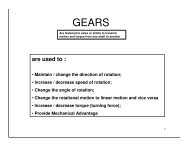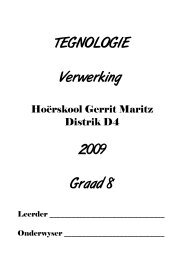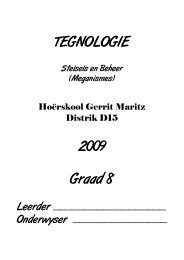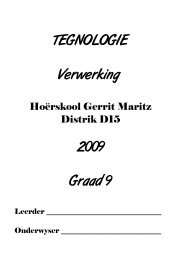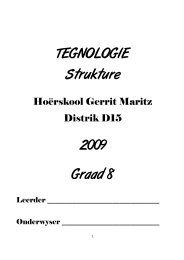TECHNOLOGY Processing 2009 Grade 9 - Tegnologie
TECHNOLOGY Processing 2009 Grade 9 - Tegnologie
TECHNOLOGY Processing 2009 Grade 9 - Tegnologie
Create successful ePaper yourself
Turn your PDF publications into a flip-book with our unique Google optimized e-Paper software.
There are a number of important points to remember when protecting wood:The protective material used . . .• should be easily absorbed by the wood• must poison organisms that attack the wood, but be safe for humans and animals.• should be readily obtainable locally• must be cost effectiveThe protective material used should not . . .• reduce the strenth of the wood• cause metals to corrode (rust) for example nails and screws• change or affect the surface of the wood• make the wood more flammablePreserving metalsIron is a metal that rusts easily by combining with oxygen in the air to form various iron oxides.Iron is the most widely used metal in industry, especially if it is alloyed to another metal toimprove its strength or its resistance to corrosion. In 1889 the Eiffel Tower was built in Paris. Thisproved the abilities of iron in construction. It has become the most widely used material in highbuildings.Iron can be painted, chromed, tinned, galvanised with zinc or even rubbed with oil. It can bealloyed with chrome, vanadium, tungsten and titanium.A metal is a substance that conducts electricity and heat well. All metals are shiny - you mayhave to clean off the oxide coating before you see the shine. They are malleable (can be pressedinto shapes) and ductile (can be stretched to form wire). Most metals have high melting points(and even higher boiling points).Copper is used for most electric wire because it is an excellent conductor, and it does not rust(corrode) easily. It is also used for household objects.Gold and platinum are used in industry and jewellery because they do not rust at all. Platinum isused for jewellery and chemical catalysts. Gold is used for jewellery and very thin wires.Other useful metals are aluminium (for cans, aeroplane bodies, cooking foil, pots), iron (for cans,construction, tools, cutlery, steel wire, steel springs, cars, ships, and so on.) and lead (forplumbing).Some metals are alloyed (mixed) with the above-mentioned metals to improve their properties.For example:• stainless steel is an alloy of chrome and iron• tool steel is an alloy of vanadium and iron• tungsten and iron gives a very hard steel for cutting tools and electric light bulb filaments• brass is an alloy of copper and zinc (used for brass door handles, hinges)• bronze is an alloy of tin and copper (used for bronze for statues, machines parts andbearings).We saw earlier that iron rusts easily. Iron can be protected by coating it with paint, or withanother metal that does not rust as easily: tin on iron (tin cans), zinc on iron (galvanised ironroofing sheets, fencing wire, pipes). The protection is very effective if undamaged. Once themetal coating has been damaged, the iron will begin to rust. The rate of the corrosion now willactually be faster than normal for uncoated iron.3




